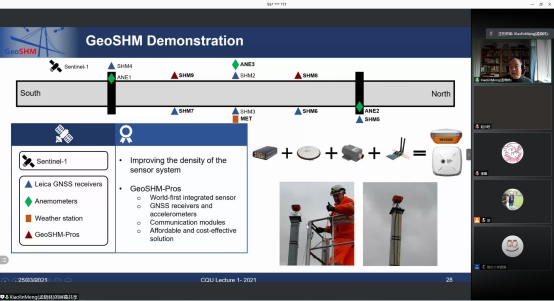On March 25, 2021, Xiaolin Meng, Professor of Intelligent Mobility from the United Kingdom, was invited by school of Civil Engineering, CQU to give presentation titled "GNSS, EO & ML for Intelligent Structural Health Monitoring of Long-span Bridges" to the students and the researchers at via Tencent platform . This academic report was presided by Professor Qiang Xie, associate chair of SCE.
First of all, Prof Xie introduced Professor Meng Xiaolin to online attendees, and expressed his heartfelt thanks to Professor Xiaolin Meng. Professor Meng' started his presentation by introducing the bridge monitoring experiment using GPS for the first time in the 1990s, and talked in detail the development history of bridge health monitoring techniques, health monitoring necessities, health monitoring significance, and relevant technical details; Then, Professor Meng introduced the integrated application and development of Earth Observation Technology (EO) and Satellite Navigation and Positioning Technology (GNSS) in bridge health monitoring based on the completed British Forth Road Bridge real-time online health monitoring system (GeoSHM). Detailed explanations on monitoring system layout, benchmark unification, data collection, processing, analysis and decision-making, hardware and software composition, etc., to reveal the influence of temperature, wind speed, and atmospheric pressure on geometric deformation, and explained "how to use machine learning methods scientifically to establish a one-to-one correspondence between load and deformation", making a useful attempt to intelligently predict the health of the bridge. At the same time, he introduced how INSAR technique was applied to benchmark change detection and structural change detection around large-scale projects, and demonstrated the real-time monitoring results of Forth Road Bridge; He summarized the related technologies of the structure monitoring system from the directions of sensors, data acquisition, data storage, communication, data management, and shared the problems that need further research in this field and the reasons for the research. At the same time, he conducted an in-depth exchanges and discussions on relevant issues with the online researchers. In the end, Prof Xie summarized the exchange and once again expressed his gratitude to Prof Xiaolin Meng for his englightening report.
Xiaolin Meng, Ph.D. graduated from Tongji University and the University of Nottingham, Professor of Intelligent Mobility, Doctoral Supervisor, Fellow of the Royal Institute of Navigation (UK), Director of the Sino-UK Geospatial Engineering Centre, serving as a guest or distinguished professor of 7 famous domestic universities including Chongqing University, Tongji University and Wuhan University etc. He was elected to the "Hundred Talents Program" of the British Research Council. He has served as the head of positioning and navigation technology at the University of Nottingham in the UK for a long time, as well as the relevant working group leader of the "International Bridge Maintenance and Safety Committee, the International Association of Surveyors (FIG), and the International Association of Geodesy (IAG)". he has engaged in the long-term research and development of bridge structure health monitoring sensor system, intelligent transportation, precision agriculture, GNSS navigation and positioning, multi-sensor integration and algorithm, indoor and outdoor seamless positioning, etc. He undertook the deformation monitoring of Edinburgh's Fortune Bridge, obtained dozens of ESA and Innovate UK government research projects such as intelligent unmanned driving of vehicles, intelligent navigation of farm vehicles, etc., with scientific research funding of about 18 million pounds, and published more than 330 leading journal and SCI papers in total. The intelligent bridge monitoring system he developed won The Engineer Collaborate to Innovate 2019 Award, a leading UK civil engineering industry award. He also led the development of InSAR millimeter-level monitoring data processing system, unmanned precision positioning system, environmental intelligent identification system, agricultural machinery intelligent navigation system, UAV soil intelligent sensing system and many other mature products, and carried out a lot of work in the aspects of technological innovation.
This academic report not only enabled the participants to have a deep understanding of the large-scale structural engineering health monitoring, but also provided a new understanding of the cross-discipline of surveying and mapping disciplines and the development of foreign engineering applications, opened up the participants’ horizons and expanded their horizons, benefiting everyone greatly.



